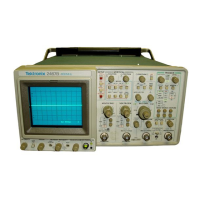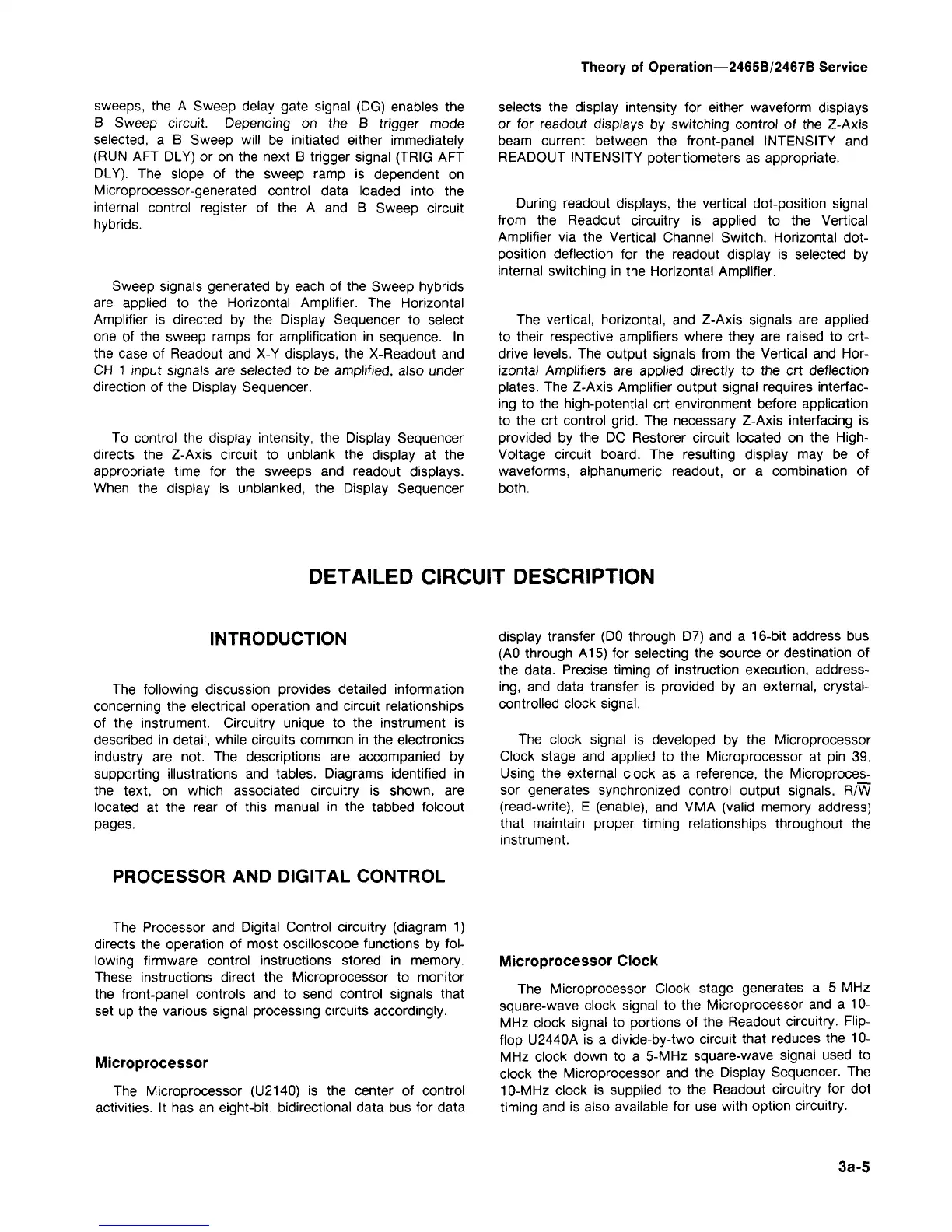Theory of Operation—2465B/2467B Service
sweeps, the A Sweep delay gate signal (DG) enables the
B Sweep circuit. Depending on the B trigger mode
selected,
a B Sweep will be initiated either immediately
(RUN AFT DLY) or on the next B trigger signal (TRIG AFT
DLY).
The slope of the sweep ramp is dependent on
Microprocessor-generated control data loaded into the
internal control register of the A and B Sweep circuit
hybrids.
Sweep signals generated by each of the Sweep hybrids
are applied to the Horizontal Amplifier. The Horizontal
Amplifier is directed by the Display Sequencer to select
one of the sweep ramps for amplification in sequence. In
the case of Readout and X-Y displays, the X-Readout and
CH 1 input signals are selected to be amplified, also under
direction of the Display Sequencer.
To control the display intensity, the Display Sequencer
directs the Z-Axis circuit to unblank the display at the
appropriate time for the sweeps and readout displays.
When the display is unblanked, the Display Sequencer
INTRODUCTION
The following discussion provides detailed information
concerning the electrical operation and circuit relationships
of the instrument. Circuitry unique to the instrument is
described in detail, while circuits common in the electronics
industry are not. The descriptions are accompanied by
supporting illustrations and tables. Diagrams identified in
the text, on which associated circuitry is shown, are
located at the rear of this manual in the tabbed foldout
pages.
PROCESSOR AND DIGITAL CONTROL
The Processor and Digital Control circuitry (diagram 1)
directs the operation of most oscilloscope functions by
fol-
lowing firmware control instructions stored in memory.
These instructions direct the Microprocessor to monitor
the front-panel controls and to send control signals that
set up the various signal processing circuits accordingly.
Microprocessor
The Microprocessor (U2140) is the center of control
activities. It has an eight-bit, bidirectional data bus for data
selects the display intensity for either waveform displays
or for readout displays by switching control of the Z-Axis
beam current between the front-panel INTENSITY and
READOUT INTENSITY potentiometers as appropriate.
During readout displays, the vertical dot-position signal
from the Readout circuitry is applied to the Vertical
Amplifier via the Vertical Channel Switch. Horizontal dot-
position deflection for the readout display is selected by
internal switching in the Horizontal Amplifier.
The vertical, horizontal, and Z-Axis signals are applied
to their respective amplifiers where they are raised to crt-
drive levels. The output signals from the Vertical and Hor-
izontal Amplifiers are applied directly to the crt deflection
plates. The Z-Axis Amplifier output signal requires interfac-
ing to the high-potential crt environment before application
to the crt control
grid.
The necessary Z-Axis interfacing is
provided by the DC Restorer circuit located on the High-
Voltage circuit board. The resulting display may be of
waveforms, alphanumeric readout, or a combination of
both.
display transfer (DO through D7) and a 16-bit address bus
(AO through A15) for selecting the source or destination of
the data. Precise timing of instruction execution, address-
ing,
and data transfer is provided by an external, crystal-
controlled clock signal.
The clock signal is developed by the Microprocessor
Clock stage and applied to the Microprocessor at pin 39.
Using the external clock as a reference, the Microproces-
sor generates synchronized control output signals, R/W
(read-write), E (enable), and VMA (valid memory address)
that maintain proper timing relationships throughout the
instrument.
Microprocessor Clock
The Microprocessor Clock stage generates a 5-MHz
square-wave clock signal to the Microprocessor and a 10-
MHz clock signal to portions of the Readout circuitry. Flip-
flop U2440A is a divide-by-two circuit that reduces the 10-
MHz clock down to a 5-MHz square-wave signal used to
clock the Microprocessor and the Display Sequencer. The
10-MHz clock is supplied to the Readout circuitry for dot
timing and is also available for use with option circuitry.
DETAILED CIRCUIT DESCRIPTION
3a-5

